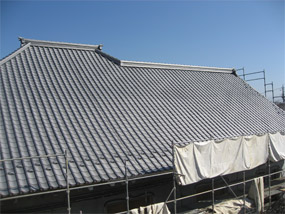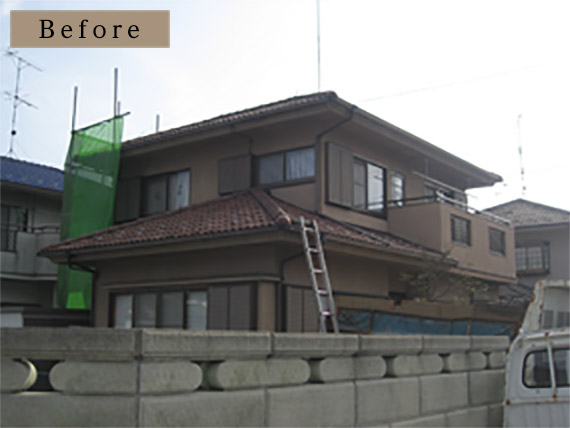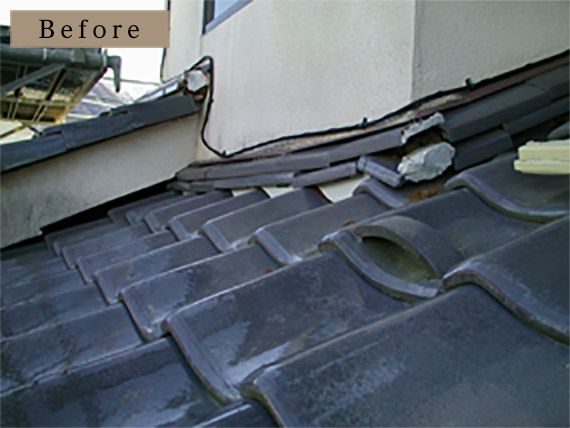
Here are a few introductions of our roofing works. In ordinary life there aren’t many opportunities to look at the roofs but each of them has individual characteristics. Please take this opportunity to find out the differences between shapes, colors and expressions of your roof.

|
 Eishiro Kawara of Sansyu Eishiro Kawara.
Eishiro Kawara of Sansyu Eishiro Kawara.
Oxidized silver colored ibushi kawara tiles, Ichimonji eaves tiles and kaezu onigawara.
Genuine Japanese style house with beautiful roof lines.
Oxidized silver color perfectly matches the wooden fascia. A beauty of Japanese houses that cannot be seen elsewhere.
Contact: Mochizuki Kengyo, Fuefuki ciry
|
 Eishiro Kawara of Sansyu Eishiro Kawara.
Eishiro Kawara of Sansyu Eishiro Kawara.
Oxidized silver colored ibushi kawara tiles, suhamayane kawara for moats and kaezu onigawara.
Gentle curves and simple suhamayane kawara. Oxidized silver color helps to create a tranquil atmosphere.
Contact: Chiba Komuten, Fuefuki city
|
|
 Wagata Basic of Sansyu Kamisei.
Wagata Basic of Sansyu Kamisei.
Glazed kawara tiles, manju eaves tiles and kaezu onigawara.
Glazed kawara tiles help to create a bright atmosphere compare to the ones with tranquil oxidized silver color.
Contact: Mochizuki Kengyo, Fuefuki city
|
 FS40 of Sansyu Noyasu
FS40 of Sansyu Noyasu
Oxidized silver-like glazed kawara tiles. Simple three-point mawarisumi on the ridge.
Not only Japanese kawara but also this western style flat kawara can help to create a Japanese taste. Glazed kawara tiles help to create a beautiful tranquil atmosphere.
Contact: Horiguchi Kengyo, Fuefuki city
|
|
 Wagata Basic of Sansyu Kamisei
Wagata Basic of Sansyu Kamisei
Glazed kawara tiles, double kawara ridges and kaezu onigawara.
Kawara ridges on the roof of a wall made of cedar bark. It required a detailed hard work but completed beautifully as a result. Cedar bark goes well with kawara.
Contact: Tanaka Zoen, Kofu
|
|

|
 Roman FF50 of Sansyu Eishiro Kawara
Roman FF50 of Sansyu Eishiro Kawara
Oxidized silver colored ibushi kawara tiles, flat 50-tile per tsubo type.
Flat ibushi kawara tiles are essential for creating a modern atmosphere with an air of stateliness. 50-tile per tsubo type brings out the beauty of the roof with its detailed lines.
Contact: Mochizuki Kengyo, Fuefuki city
|
 Kaparasu KS40 of Sansyu Eishiro Kawara
Kaparasu KS40 of Sansyu Eishiro Kawara
Oxidized silver colored ibushi kawara tiles, 40-kawara type with a large curve.
Leaving the air of stateliness yet not too thickly, ibushi kawara large curve type would be a good match if you were looking for something chic.
Contact: Suganuma Houken, Koshu city
|
|
 Kaparasu KS40 of Sansyu Eishiro Kawara
Kaparasu KS40 of Sansyu Eishiro Kawara
Glazed green kawara tiles, 40-kawara type with a large curve.
Glazed green color was released in 2010. The color made its debut quicker as it was for a friend’s new house which turned out to be a great success.
Contact: Chiba Komuten, Fuefuki city
|
|

|
 SL of Sansyu Noyasu
SL of Sansyu Noyasu
Glazed star-beige kawata tiles. Long and thin naturally mixed color, 46-kawara per tsubo type.
This SL kawara is not seen often elsewhere.
It was the client’s obsession. It may be hard to see but the roofs at Tokyo Disney Sea may use the same type of kawara.
Contact: GM corporation, Koshu city
|
 BB40 of Sansyu Eishiro Kawara.
BB40 of Sansyu Eishiro Kawara.
Glazed light yellow kawara tiles. Double-curved western style kawara creates a nice mixture of colors, 40-kawara per tsubo type.
This kawara is nowadays an essential for a western-style architecture. It can create an attractive atmosphere without actually mixing colors. Various colors are appeared as a result of being fired differently in a kiln.
Contact: Ichinose Kawara Kogyo, Fuefuki city
|
|
 UU40 of Sansyu Eishiro Kawara.
UU40 of Sansyu Eishiro Kawara.
Glazed three-color kawara tiles. Flat western style kawara creates a nice mixture of colors, 40-kawara per tsubo type.
Three-color mixed kawara roof. Unfortunately no pictures were taken from the front side. Mixed color kawara is recommended for a western style architecture.
Contact: Mochizuki Kengyo, Fuefuki city
|
|

|
 Kodaigawara of Sansyu Amaki
Kodaigawara of Sansyu Amaki
Oxidized silver colored ibushi kawara tiles. Hongawarabuki, juzukake-kimenonigawara and toriyasumi.
A very rare hakkakudo is modeled after Yumedono of Horyuji temple. The roofing work completed using a traditional honbuki technique is a must-see masterpiece.
Contact: Nakamura Kenchiku Kogyosho, Kofu
|
 Jun Ibushi Kawara of Sansyu Souka
Jun Ibushi Kawara of Sansyu Souka
Oxidized silver colored ibushi kawara tiles. Gendaibuki renovation, and kyonomaki onigawara.
2-storied hips with sumioni and ninooni. A long hip is effective when you want to add a character, it helps the roof leave a dynamic impression.
Contact: Ichinose Kawara Kogyo, Fuefuki city
|
|
 Eishiro Kawara of Sansyu Eishiro Kawara
Eishiro Kawara of Sansyu Eishiro Kawara
Oxidized silver colored ibushi kawara tiles. Gendaibuki renovation and kyonomaki onigawara.
Small but very proud looking bell tower roof. Weeds were growing on the ridges but it’s all cleaned up by a renovation.
Contact: Yamamoto Kenchiku Jimusho, Kofu
|
 Eishiro Kawara of Sansyu Eishiro Kawara
Eishiro Kawara of Sansyu Eishiro Kawara
Oxidized silver colored ibushi kawara tiles. Gendaibuki, fukikae, and kyonomaki onigawara.
The main hall has a distinctive large flat roof. Each roof has its characteristics but when we talk about Japanese tradition this oxidized color cannot be missed.
Contact: Chiba Komuten, Fuefuki city
|
|
 Eishiro Kawara of Sansyu Eishiro Kawara
Eishiro Kawara of Sansyu Eishiro Kawara
Oxidized silver colored ibushi kawara tiles. Gendaibuki renovation, and kyonomaki onigawara. Fukinagashi hononigawara.
Sumioni and ninooni are used. The roof itself is not large but the two-storied hips and a couple of tonemaru creates a gorgeous appearance.
Contact: Ichinose Kawara Kogyo, Fuefuki city
|
 Wagata Basic of Sansyu Kamisei.
Wagata Basic of Sansyu Kamisei.
Glazed kawara tiles. Gendaibuki, new construction, kyohananokikawara, Kyonomaki and botan for tomoebuta.
Three minoko, sumioni, ninooni with a large roof surface and kohai are making an impressive scene. New construction of a temple is a very rare experience.
Contact: Chiba Komuten, Fuefuki city
|

|

|

|
|

|
Super Try Type II of Sansyu Tsuruya
Glazed matted green colored kawara tiles. Renovated from cement western kawara to sansyu glazed kawara.
Cement kawara gets weathered as years go by. The kawara on this roof were severely deteriorated that it would break when stepped. As you can see in the picture the look of a house would be dramatically improved by renovating the roof.
Ichinose Kawara Kogyo, Fuefuki city
|
|
 Caresse of Taihei Sangyo
Caresse of Taihei Sangyo
Galvalume black colored kawara tiles. Kabusebuki is a technique to tile over existing kawara such as koroniaru, therefore no disposal process is required.
Caresse is a sheet-metal roofing material to tile over existing kawara such as koroniaru therefore no disposal process is required and cost efficient. Color faded roof comes back into existence and the construction period can be shorten.
Contact: Inomata, Kai city
|

|

| Restore:To return something that has been deteriorated or broken to an earlier good condition or position. |
|

|

|
|

|

|
|

|

|
For any inquiries and claims regarding the images posted on this website please contact us so that we could take necessary actions.





























